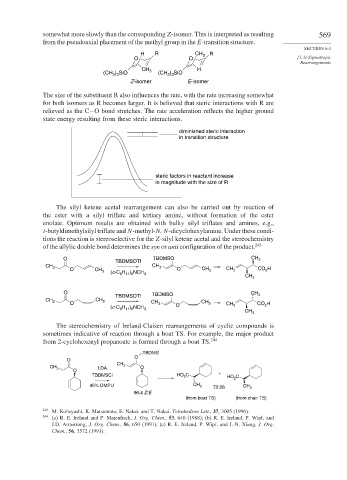Page 595 - Advanced Organic Chemistry Part B - Reactions & Synthesis
P. 595
somewhat more slowly than the corresponding Z-isomer. This is interpreted as resulting 569
from the pseudoaxial placement of the methyl group in the E-transition structure.
SECTION 6.4
H R CH 3 R
O O [3,3]-Sigmatropic
Rearrangements
CH 3 H
(CH ) SiO (CH ) SiO
3 3
3 3
Z-isomer E-isomer
The size of the substituent R also influences the rate, with the rate increasing somewhat
for both isomers as R becomes larger. It is believed that steric interactions with R are
relieved as the C−O bond stretches. The rate acceleration reflects the higher ground
state energy resulting from these steric interactions.
diminished steric interaction
in transition structure
steric factors in reactant increase
in magnitude with the size of R
The silyl ketene acetal rearrangement can also be carried out by reaction of
the ester with a silyl triflate and tertiary amine, without formation of the ester
enolate. Optimum results are obtained with bulky silyl triflates and amines, e.g.,
t-butyldimethylsilyl triflate and N-methyl-N N-dicyclohexylamine. Under these condi-
tions the reaction is stereoselective for the Z-silyl ketene acetal and the stereochemistry
of the allylic double bond determines the syn or anti configuration of the product. 243
O TBDMSO CH 3
TBDMSOTf
CH CH
3
O CH 3 O CH 3 CH 2 CO H
2
3
H ) NCH
(c-C 6 11 2 3
CH 3
O CH
TBDMSOTf TBDMSO 3
CH CH
3
O 3 CH 3 O CH 3 CH CO H
(c-C H ) NCH 3 2 2
6 11 2
CH 3
The stereochemistry of Ireland-Claisen rearrangements of cyclic compounds is
sometimes indicative of reaction through a boat TS. For example, the major product
from 2-cyclohexenyl propanoate is formed through a boat TS. 244
TBDMS
O
O
CH
CH 3 LDA 3 O
O
TBDMSCl HO C + HO C
2
2
45% DMPU CH 3 72:28 CH 3
96:4 Z:E
(from boat TS) (from chair TS)
243 M. Kobayashi, K. Matsumoto, E. Nakai, and T. Nakai, Tetrahedron Lett., 37, 3005 (1996).
244
(a) R. E. Ireland and P. Maienfisch, J. Org. Chem., 53, 640 (1988); (b) R. E. Ireland, P. Wipf, and
J.D. Armstrong, J. Org. Chem., 56, 650 (1991); (c) R. E. Ireland, P. Wipf, and J.-N. Xiang, J. Org.
Chem., 56, 3572 (1991).

